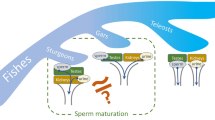Abstract
In vitro investigations of the metabolism of mammalian spermatozoa have amply demonstrated their ability to utilize a variety of glycolysable and oxidizable substrates1. No information is, however, available on the metabolism of spermatozoa within the female reproductive tract. If, as is probable, the epithelial cells use up not only the glucose supplied by the circulatory system, but also oxidizable intermediates such as pyruvate and lactate, the spermatozoa in contact with those cells would have to oxidize their endogenous reserves of lipid material, provided that the oxygen tension in the various regions of tho tract is adequate to support the aerobic metabolism of the spermatozoa. In the absence of external substrates the conditions in the female genital tract would not be favourable for the survival of spermatozoa for prolonged periods of time. Whereas this may not affect fertility in animal species in which mating occurs at the time of oestrus, with rapid ascent of an adequate number of spermatozoa, a limited survival capacity due to the lack of substrates may affect the prospects of fertilization in man.
This is a preview of subscription content, access via your institution
Access options
Subscribe to this journal
Receive 51 print issues and online access
$199.00 per year
only $3.90 per issue
Buy this article
- Purchase on Springer Link
- Instant access to full article PDF
Prices may be subject to local taxes which are calculated during checkout
Similar content being viewed by others
References
Mann, T., The Biochemistry of Semen and of the Male Reproductive Tract, 282 (Methuen and Co. Ltd., London, 1964).
Sturgis, S. H., Fertil. and Steril., 7, 468 (1956).
Kurzrok, R., and Birnberg, C., Intern. J. Fertil., 3, 134 (1958).
Terner, C., Amer. J. Physiol., 198, 48 (1960).
Harpur, R. P., and Quastel, J. H., Nature, 164, 693 (1949).
Brown, D. H., Biochim. Biophys. Acta, 7, 487 (1951).
Terner, C., and Minassian, E. S., Fed. Proc., 24, 476 (1965).
Terner, C., and Korsh, G., Biochemistry, 1, 367 (1962).
Terner, C., and Korsh, G., J. Cell and Comp. Physiol., 62, 251 (1963).
Folch, J., Lees, M., and Sloane Stanley, G. H., J. Biol. Chem., 226, 497 (1957).
Leloir, L. F., and Cardini, C. E., in Methods of Enzymology, edit. by Colowick, S. P., and Kaplan, N. O., 5, 418 (Academic Press, New York, 1962).
Comb, D. G., and Roseman, S., ibid., 442.
Author information
Authors and Affiliations
Rights and permissions
About this article
Cite this article
TERNER, C. Oxidative and Biosynthetic Utilization by Human Spermatozoa of a Metabolite of the Female Reproductive Tract. Nature 208, 1115–1116 (1965). https://doi.org/10.1038/2081115a0
Issue Date:
DOI: https://doi.org/10.1038/2081115a0
Comments
By submitting a comment you agree to abide by our Terms and Community Guidelines. If you find something abusive or that does not comply with our terms or guidelines please flag it as inappropriate.



